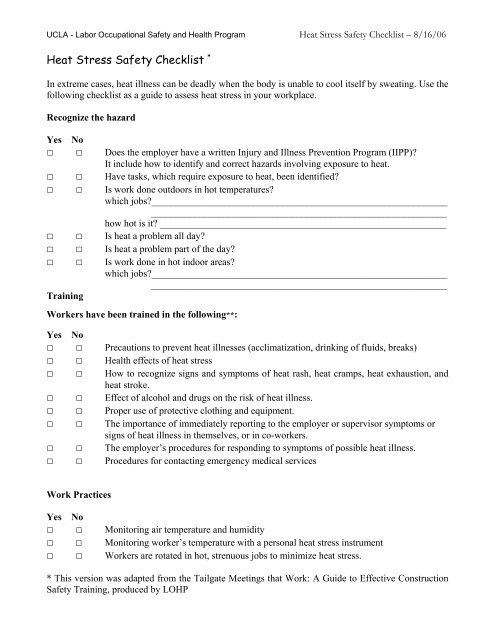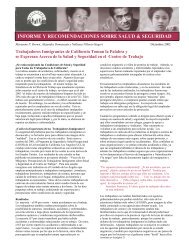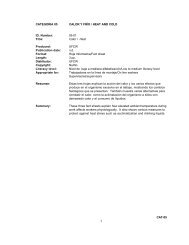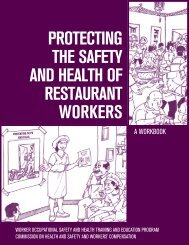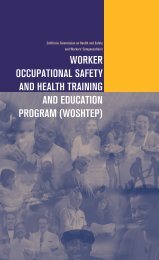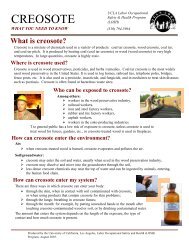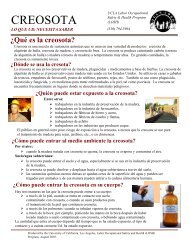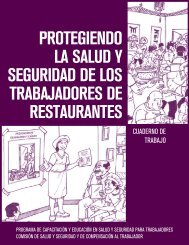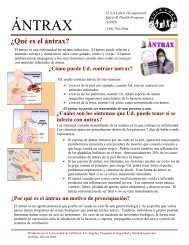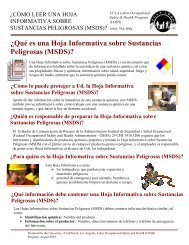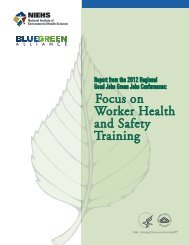Heat Stress Safety Checklist * - UCLA LOSH
Heat Stress Safety Checklist * - UCLA LOSH
Heat Stress Safety Checklist * - UCLA LOSH
You also want an ePaper? Increase the reach of your titles
YUMPU automatically turns print PDFs into web optimized ePapers that Google loves.
<strong>UCLA</strong> - Labor Occupational <strong>Safety</strong> and Health Program <strong>Heat</strong> <strong>Stress</strong> <strong>Safety</strong> <strong>Checklist</strong> – 8/16/06<strong>Heat</strong> <strong>Stress</strong> <strong>Safety</strong> <strong>Checklist</strong> *In extreme cases, heat illness can be deadly when the body is unable to cool itself by sweating. Use thefollowing checklist as a guide to assess heat stress in your workplace.Recognize the hazardYes No□ □ Does the employer have a written Injury and Illness Prevention Program (IIPP)?It include how to identify and correct hazards involving exposure to heat.□ □ Have tasks, which require exposure to heat, been identified?□ □ Is work done outdoors in hot temperatures?which jobs?__________________________________________________________________________________________________________________________how hot is it? ___________________________________________________________□ □ Is heat a problem all day?□ □ Is heat a problem part of the day?□ □ Is work done in hot indoor areas?which jobs?__________________________________________________________________________________________________________________________TrainingWorkers have been trained in the following**:Yes No□ □ Precautions to prevent heat illnesses (acclimatization, drinking of fluids, breaks)□ □ Health effects of heat stress□ □ How to recognize signs and symptoms of heat rash, heat cramps, heat exhaustion, andheat stroke.□ □ Effect of alcohol and drugs on the risk of heat illness.□ □ Proper use of protective clothing and equipment.□ □ The importance of immediately reporting to the employer or supervisor symptoms orsigns of heat illness in themselves, or in co-workers.□ □ The employer’s procedures for responding to symptoms of possible heat illness.□ □ Procedures for contacting emergency medical servicesWork PracticesYes No□ □ Monitoring air temperature and humidity□ □ Monitoring worker’s temperature with a personal heat stress instrument□ □ Workers are rotated in hot, strenuous jobs to minimize heat stress.* This version was adapted from the Tailgate Meetings that Work: A Guide to Effective Construction<strong>Safety</strong> Training, produced by LOHP
<strong>UCLA</strong> - Labor Occupational <strong>Safety</strong> and Health Program <strong>Heat</strong> <strong>Stress</strong> <strong>Safety</strong> <strong>Checklist</strong> – 8/16/06Work Practices (Cont.)Yes No□ □ Strenuous work is done during cooler parts of day (early morning or evenings) whenfeasible.□ □ Workers not used to hot environment are given lighter work during the first week on thejob.□ □ Provision of clean, cool, and potable water readily available on the site**.Workers drink a quart an hour or more, depending on conditions and their level ofexertion.□ □ Rest breaks* *.Workers who feel heat related symptoms are able to take a break of at least five minutesin an area with shade and good ventilation.□ □ Workers use the “buddy system” to recognize signs of heat illness in each other(including weakness, unsteady pace, irritability, disorientation, and changes of skincolor).□ □ First aid supplies and equipment are available.□ □ Workers know how to contact emergency services.□ □ Workers know how to effectively report the work location to 911.For outdoor environments□ □ Access to shade**.A shaded area should be provided for breaks and when workers need relief from thesun. Preferred methods of providing shade: umbrellas, canopies, tarps, trees, and/orstructures.Protective Clothing and EquipmentYes No□ □ Workers are provided water – or air-cooled garments, ice-packet vest in extremely hotenvironments.□ □ Frequent breaks are given to workers wearing hot personal protective equipment.In very hot conditions, breaks are taken in an air-conditioned area, if feasible.For outdoor environments□ □ Workers wear loose, light-colored, lightweight cotton clothing and wide-brimmed hatswhen in the sun.□ □ Workers always keep on lightweight long-sleeve shirts and long pants if thetemperature is over 95ºF.□ □ When in the sun, workers use sunscreen products with a sun protection factor (SPF) ofat least 15.** Cal/OSHA requires all employers with outdoor worksites to take those steps to prevent heatillness.


